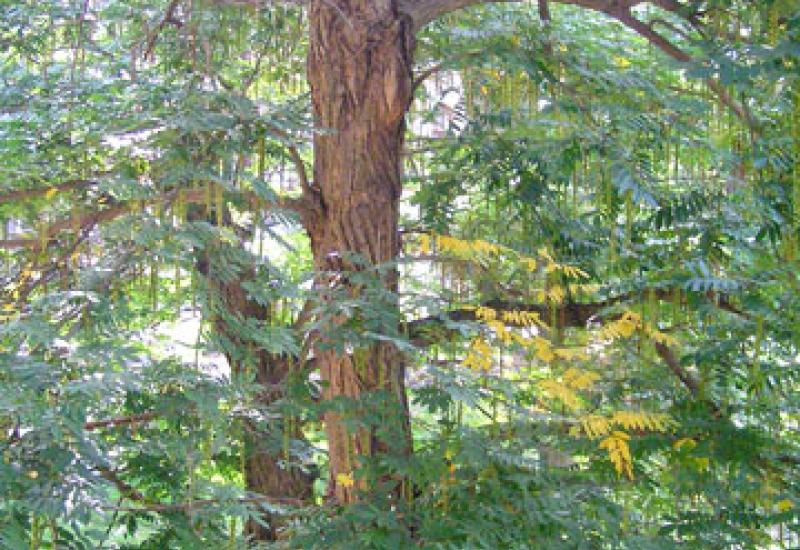Park KPI is not only an decoration of the university territory, it can be considered a hallmark of the district and the city. Part of the collection was assembled over a century ago, from different continents and climate zones, preserved to this day to the admiration and delight. Now there are about 90 species of trees and shrubs in the park NTUU"KPI", thus it can be classified as dendropark. "Kiev Polytechnic" already talked about some interesting trees in it – Rhus cotinus L. (before the main body), the sumac (near the museum), ginkgo biloba (near CCA) and others. But there is in the park one more exotic plant, which by its unusual form attracts the attention all year round. This - Lapin box elder (Pterocarya pterocarpa) nut family (Juglandaceae). Yet it is called Lapin kriloplidna, krilogorishnik Caucasian, Caucasian or pterokariya pterokariya box elder. Tree has a nice look during the flowering period, and especially beautiful it is when the fruits ripen, grow in hanging earrings brush to half a meter in length and emerald cascaded across the crown. At this time pterokariya resembles green waterfall. "Winged" nuts ripen in September-October and remain on the branches almost all winter. This tree is liked by local squirrels. All winter they briskly paced along the branches, searching for food. Several Lapina trees choose area at the front of the rector’s wing opposite of the pump room. Last year's hurricanes noticeably damaged relics, but now they stand in its lush beauty. Visitors deanery FMM gladly admire the green beauty through the windows of the second floor.
 Pterokariya is naturally prevalent in Turkey and Iran, Central Asia, you can find it at the Caucasus. It grows mainly in the lower mountain zone and in the lowlands. Very water-loving, so it is occupying riverbanks on clay and loamy soils rich in humus. Survives on poor lands, but does not tolerate dry air and soil. Insufficient frost-resistant: prolonged exposure to low temperatures lead to frosting up skeletal branches, but usually the tree recovers well. It reproduces by cuttings and seeds. Single trees and small groups are found in the mountains to an altitude of 1000 and even 1200 m. Lapina is growing relatively quickly, has an extensive root system, so it is used to strengthen the shoreline. It lives up to 200 years. The wood is white, light, loose, not too strong. Europeans learned about Lapin at the end of the XVIII century, after French botanist A.Misho travel to Asia. Pterokariya first was described as a nut-leaved (Juglans fraxinifolia) in 1797 for the tree in the garden of the Paris museum.
Pterokariya is naturally prevalent in Turkey and Iran, Central Asia, you can find it at the Caucasus. It grows mainly in the lower mountain zone and in the lowlands. Very water-loving, so it is occupying riverbanks on clay and loamy soils rich in humus. Survives on poor lands, but does not tolerate dry air and soil. Insufficient frost-resistant: prolonged exposure to low temperatures lead to frosting up skeletal branches, but usually the tree recovers well. It reproduces by cuttings and seeds. Single trees and small groups are found in the mountains to an altitude of 1000 and even 1200 m. Lapina is growing relatively quickly, has an extensive root system, so it is used to strengthen the shoreline. It lives up to 200 years. The wood is white, light, loose, not too strong. Europeans learned about Lapin at the end of the XVIII century, after French botanist A.Misho travel to Asia. Pterokariya first was described as a nut-leaved (Juglans fraxinifolia) in 1797 for the tree in the garden of the Paris museum.
In vivo – this is a large deciduous tree up to 30 m tall with a trunk of 100-150 cm in diameter (in Ukraine pterokarii height does not exceed 15 m). Upper branches of tree are sprawling, pretty loose. The trunk of the young tree is straight , with smooth light gray bark; in the old bark dark gray, longitudinally fissured. The leaves are large, pinnate, with a total length of 45 cm, light green in summer and bright yellow in autumn, consist of 11-15 small leaves. The tree blossoms in April - May. It has greenish small unisexual flowers. Male inflorescences are located at the base of young shoots, form linear spikelets 5-10 cm long, female inflorescences are in the axils of the upper leaves and catkins collected in length of 10-15 cm. The female flower is the corolla, which envelops the fruit after pollination. Therefore, each nut has two short hard wings that after maturation help them dissipate.
Once again, let’s admire the beauty of handmade KPI park and gratefully recall predecessors, who created and built the Kiev Polytechnic, leaving us a legacy of a glorious and beautiful garden.

